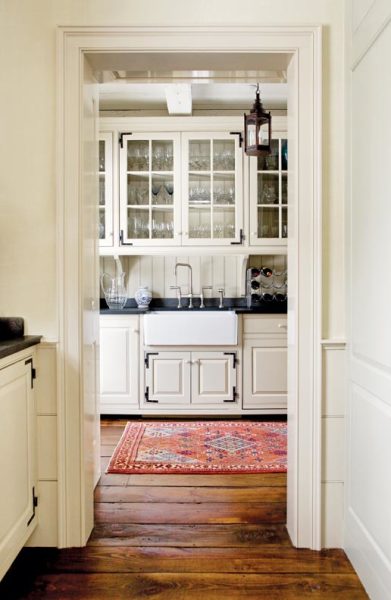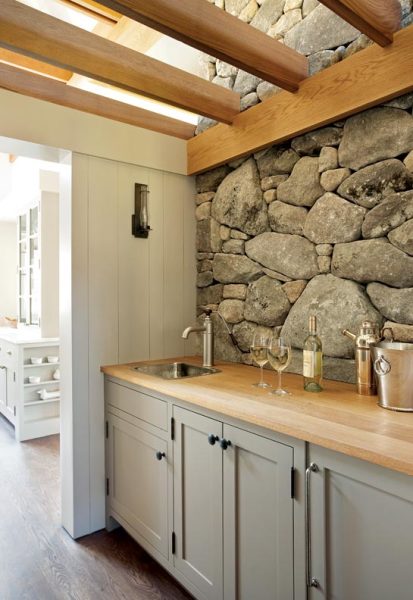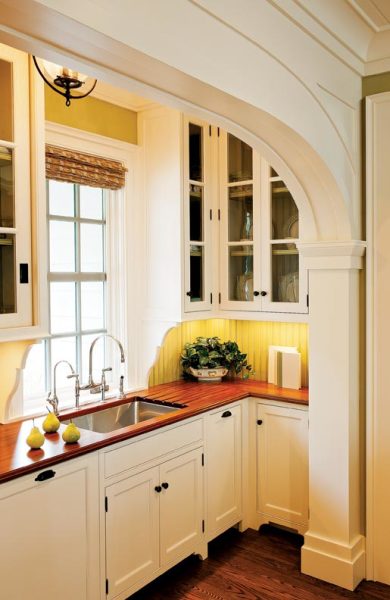Architect Gil Schafer incorporated a large farmhouse sink, glass cabinets, L-hinges, and a historically inspired lantern in the pantry in this New York new old house. (Photo: Eric Roth)
As Catherine Seiberling Pond explains in The Pantry: Its History and Modern Uses, “Early butteries or pantries were primitively fashioned storage areas with open, unpainted shelves and barrels for flour, sugar, and other provisions kept below. Butter churning, cheese pressing, bread making, and other preparations took place in the pantry, with the lower shelves doubling as counter space.”
From these early precursors, pantries have not changed greatly in function, but their look and layout have evolved in terms of sophistication. Even as homeowners and designers are infusing them with more amenities, from appliances to the latest storage solutions, historic appearances befitting a new old home can still be achieved through thoughtful detailing.
Storage Pantry
A storage pantry can be its own room, closed off by doors, or it might be a hallway or nook off the kitchen. For existing homes that are low on space, a pantry can be as simple as a freestanding furniture piece positioned within the kitchen. Brian Yahn of Plain & Fancy Custom Cabinets explains that these cabinets, when custom-made, can mimic the look of antique furniture outside but offer a surprising amount of storage efficiency inside.
“We’ve crafted what we call ‘chef’s pantries’ with up to 50 shelves for storing dry and canned goods and racks for spices,” he says. “We also make pull-out pantries whose doors store a tremendous amount of dry goods,” he adds.
Hutker Architects designed this traditional farmhouse pantry on Martha’s Vineyard using natural materials such as stone and wood in conjunction with Shaker-style cabinet profile to enhance the traditional feel. (Photo: Eric Roth)
In many cases, modern pantries have moved beyond food organization to act more broadly as “multipurpose storage areas,” says Kevin Ritter of Timeless Kitchen Design. In addition to dry goods, cans, wine, liquor, and even bins of fruit and root vegetables, their stock might include cleaning supplies, serving dishes, linens, cookbooks, and small appliances.
Yahn agrees that pantries have taken on the role of catch-all, accepting increased overflow from a busy kitchen. “A pantry is a great spot for an appliance that is either used infrequently, such as a stand mixer, or is a little noisy, such as an ice maker,” he says. “If generous in size, a pantry can also act as an out-of-the-way spot for a particular aspect of meal prep or cleanup, keeping messes and dishes out of the kitchen during dinner parties, for example.”
Butler’s Pantry
Butler’s pantries were more common in wealthy homes outfitted with domestic staff and silver or china collections. Typically positioned as a transitional area between a kitchen and dining room, the butler’s pantry would not only organize valuable wares but also act as a workspace where staff might polish silver or update the wine log or merchant account books.
Today, butler’s pantries are similarly used for serving functions. They are home to china, glassware, platters, pitchers, and other items suitable for entertaining but not typically needed for everyday meals. And more so than a food storage pantry, a butler’s pantry will contain glass-front upper cabinets as well as some open shelving for showcasing collectibles.
In turn-of-the-century homes, sinks began appearing in butler’s pantries, often crafted out of either copper or nickel silver. Now these prep or bar sinks are typically paired with appliances—ice makers, wine coolers, bar refrigerators, and even dishwashers—geared toward drink preparation, entertaining ease, and party cleanup.

Pantry Design
“I find that customers have a tendency to be more bold in their design decisions for pantries, particularly when they are closed off by doors,” observes Ritter. “In this case, customers can select a different cabinet finish and even door style or hardware since the space is so separate. But the more public the pantry is to the kitchen, the more important it is that the cabinetry in the two areas either match or coordinate.”
Pantries allow for creative countertop decisions as well. Since their workspaces are typically smaller than more expansive kitchen countertops, homeowners can invest in finished wood, particularly when a sink is not present. Natural materials such as slate, soapstone, and marble are also appropriate.
Open shelving is the best choice for achieving the look of an older pantry, and is also less expensive than custom cabinets. However, homeowners must consider the drawbacks: Stored items are always on display, and there is no protection from accumulating dust. Ritter finds that most clients will choose open shelving in strategic areas but prefer the orderliness and protection of cabinet doors for the bulk of their pantry design. And to showcase key items, they opt for cabinets faced with antique glass.
In order to assure that pantry cabinets are traditional in style, Ritter recommends keeping the size of their openings small. “This restraint leads to the feeling that the pieces are old,” he says. “We want our cabinets to look more like furniture and less like rows of standard 18″ or 24″ manufactured boxes.” Historic finishes such as milk paint and light distressing add to the illusion of age as well. Appliances should be concealed with front panels when possible.
Drawer organizers, pull-out racks, spice racks, swing-out units, and other organizational innovations can be incorporated into cabinets that outwardly don’t betray the features within. Other creative touches in tune with traditional pantry designs include rolling ladders for accessing very tall upper cabinets or shelving. When ladders aren’t possible, step stools enhance vertical reach, although they take up floor space. Plain & Fancy developed a step stool that can be folded and stored unobtrusively inside the toe kick of a base cabinet.
“Ultimately, whenever we meet with clients and ask them what they don’t like about their existing kitchen, the likely response is that it doesn’t have enough storage,” says Yahn. “With its additional workspaces and organizational possibilities, a pantry is always part of the solution. It takes pressure off the kitchen while adding to a home’s traditional feel.”







